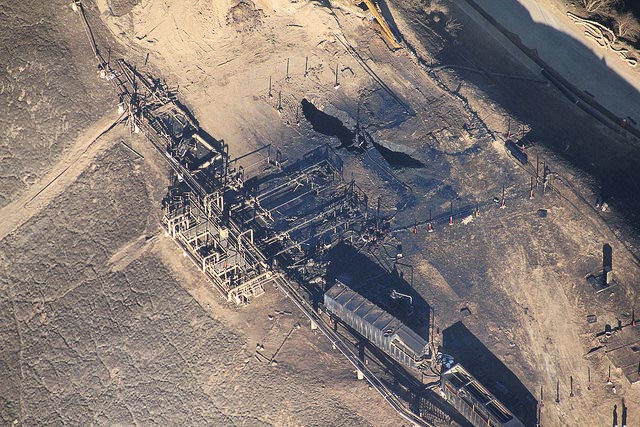Before SoCalGas plugged the methane leak at its Aliso Canyon natural gas storage facility in Los Angeles earlier this year, state officials made clear the company would have to pay to counteract the damage: 107,000 tons of methane emissions released into the atmosphere, which statewide emissions by 20 percent during the four months the leak was active.
It was the largest methane leak in U.S. history, a study published in the journal Science later found. It caused Gov. Jerry Brown to declare a state of emergency. More than 6,000 households had to be relocated to get away from the leak’s harmful effects.
A state agency has released its plan for SoCalGas to offset the damage the methane leak caused. While the company is now battling with that agency over particulars, the plan itself is built on an innovative concept. The premise is that offsets should be geared towards making long-term environmental changes for the state.
David Clegern, spokesman for California’s Air Resources Board, said there are two waves of changes the agency is asking from SoCalGas. The first relates to the leak’s immediate effects.
“The second wave is to do things that would be transformational for the industry, to put something in place that gets major reductions long-term.”
That is, the agency wants SoCalGas to pay for projects that won’t just result in one drop in emissions. It wants the natural gas provider to pursue projects that will tip the incentives for the largest methane producers – farmers – so they’ll choose to invest in emissions-reducing projects on their own.
Clegern said doesn’t know the cost of the programs it is asking SoCalGas to pursue – even a general estimate. The program is geared towards reaching a benchmark reduction in methane emissions. And all of the reductions need to come from new initiatives – neither the board nor SoCalGas can latch on to existing programs and count them as mitigation. Essentially, the hope is that from disaster can come innovation.
But the debate about the specifics continues. In a January emergency proclamation, Gov. Jerry Brown declared the company would be responsible for funding a program to mitigate the methane leak’s emissions.
The company at the time told local media it planned to do just that – pay for all costs of plugging and mitigating the leak, at no expense to ratepayers.
The state’s Air Resources Board released its formal mitigation plan at the end of March, but SoCalGas has taken issue with some of the program’s elements.
The company reacted to the program with a letter objecting to the Air Resources Board’s emissions estimate and to the mitigation standard to which it held the company.
That latter issue gets to the heart of the disagreement. ARB measured the contribution of the methane leak on a 20-year time-horizon. SoCalGas contends a 100-year horizon is more appropriate. Because the worst effects of methane play out quickly, a shorter time frame would amplify the impact of the leak, on paper, and a longer time frame would make it appear less devastating.
Driving the legal dispute over the proper regulatory standard, though, is a matter of money, Clegern said.
“They want us to use a 100-year measure because it will save them a lot of money,” he contents. SoCalGas executives say they just want the state to use the same standards it's used in the past.
When Brown issued his executive order, he specifically directed the ARB to focus on the shorter timeframe.
“This mitigation program shall be funded by the Southern California Gas Company, be limited to projects in California, and prioritize projects that reduce short-lived climate pollutants,” he wrote.
Representatives from SoCalGas did not respond to a request for comment.
In any case, Clegern said ARB’s plan would have SoCalGas make investments that in future years would tip incentives for farmers and landfill operators to change the way they handle methane emissions.
For instance, SoCalGas may be responsible for funding a project that would cover an existing landfill that seeps methane – such as the Sunshine Canyon Landfill, which is near the Aliso Canyon leak – and route its methane into a converter that burns it into electricity and taps it into the power grid.
Likewise, the company could be forced to fund projects that would allow dairy farmers – an industry responsible for 45 percent of the state’s methane emissions – to capture their methane emissions and feed them back into the grid.
“What we’re trying to do is create a system where it’s worth a farmer's while to scrape their manure into a digester and convert it into energy, instead of just throw it in a (container) and emit methane,” Clegern said. “That’s critical because it’s virtually unregulated right now.”
Currently, some farmers capture methane emissions for their own energy. The missing piece is infrastructure that takes the emissions from the farm and tapping them into the grid, Clegern said. Solving that issue – and potentially with the costs covered with SoCalGas – holds the promise of changing farmers’ decisions of whether it’s a worthwhile investment. If it is, the implications may extend beyond California.
“The energy grid in the West is changing dramatically anyway, simply because it has to,” Clegern said. “We’re trying to work in way that integrates this so that the momentum from cleanup will continue.”

